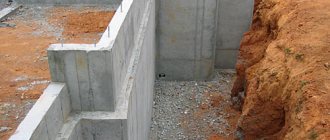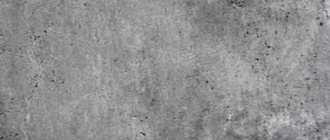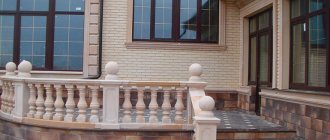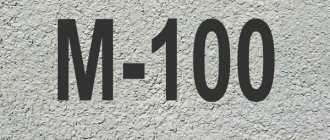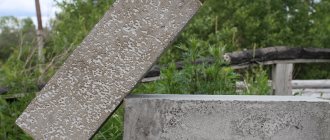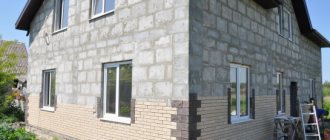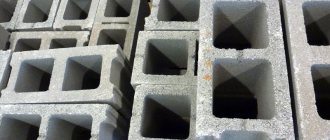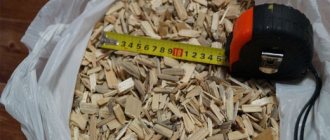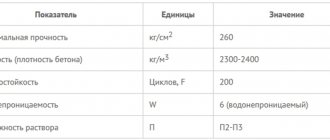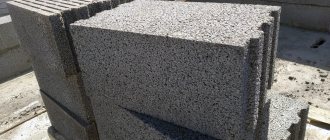Concrete canvas (English Concrete Canvas or CC) is a flexible fabric material impregnated with concrete, which, in the process of interaction with water, hardens and creates a durable, thin layer of concrete, resistant to fire and water. The material is very easy to install and reliable in operation, requiring a minimum of people, effort and time for installation.
All that is needed to create a strong and reliable layer of concrete is to lay a roll on the object and then pour water on it. Due to the passage of the hydration reaction, the concrete will harden and within a day will be suitable for use. Concrete is supplied in rolls, made on the basis of a cement-sand mixture located between two layers of non-woven textiles.
Standard concrete sheets include 3-dimensional fibers in the structure, which are impregnated with a specially formulated dry concrete mixture. Due to the special arrangement of the fabric fibers, the canvas becomes waterproof after the first interaction with water. Primary hydration is carried out by spraying or completely immersing the material in water.
After the coating is installed, it sets and creates a durable layer that is not afraid of external influences and eliminates the possibility of cracks spreading. In total, there are 3 main types of material on the market - CC5, OV8, CC13 (thickness 5, 8 and 13 millimeters, respectively).
Concrete fabric is actively used in civil and industrial (even military) construction, it allows you to improve the relief and preserve soil from movement, protect various objects, quickly and efficiently construct buildings, etc. The material is becoming more and more popular every day, finding different types of applications.
What is concrete canvas?
Concrete sheet or, as it is also called, concrete canvas, is a thin layer of concrete enclosed between two sheets of non-woven textile material. The result is a flexible and strong material with many useful properties.
Appearance of all layers of concrete sheet Source Gozetim.com
The main component of the canvas is dry concrete mixed with special textile fibers. The chemical composition of the mixture is selected in such a way that upon contact with water, the concrete-fication process starts, due to which the canvas becomes absolutely waterproof.
What is rolled concrete and how can it be used on site?
One way or another, almost no construction project can be completed without concrete. The main problems with its use are the labor-intensive work of mixing and pouring the solution and the long drying time. However, there is concrete that is devoid of these “disadvantages”, as it is produced. in rolls
Rolled concrete is a product of the Concrete Canvas (CC) technology, developed about 10 years ago in the UK. Other names for the material are concrete sheet, canvas, concrete fabric. Its use allows you to create strong and durable concrete coatings in an ultra-short time without the use of formwork, mixers, processes of applying and compacting the mixture. It is enough to roll out the rolls on the surface and moisten the canvas with water, resulting in the formation of a thin, waterproof layer of concrete that is resistant to fire, various mechanical loads and aggressive environments.
The material is environmentally friendly (there is no emission of harmful substances), and is not subject to water and wind erosion. It does not deteriorate under the influence of ultraviolet radiation, withstands up to 300 freeze-thaw cycles and is suitable for use in any climatic zones (operating temperature range –60. +90⁰С). According to manufacturers' calculations, the service life of the coating is at least half a century.
Rolled concrete SS is a flexible layered sheet. The surface layer consists of tightly knit hydrophilic textile fibers,
holding the modified cement mixture inside the material, preventing it from being washed out during pouring and performing the function of reinforcement.
Below is a voluminous fiber matrix
with a mixed filler, which prevents it from moving when rolling the roll onto vertical and inclined bases and thereby maintains a uniform density of the web.
In addition, it prevents the propagation of cracks after the concrete has hardened and increases the tensile strength of the coating. Next comes another reinforcing layer of synthetic fabric
saturated with cement, and from below the entire “sandwich” is covered with
a waterproofing backing made of PVC film.
After the canvas is wetted, the concrete hardens within 1-2 hours; within 24 hours it gains 80% strength, which corresponds to grade M 150, and over the next 10 days the compressive strength of the material reaches 40 MPa
A type of rolled concrete CC is the CCH (Hydro) canvas, which is supplemented with a bottom layer of waterproof geomembrane.
It protects the PVC substrate from mechanical damage and has increased resistance to toxic and caustic chemicals - hydrocarbons, acids, etc. The use of CCH allows you to reliably protect the base without using additional waterproofing materials for this purpose.
Release forms
Products are produced in Bulk Roll format (large unpackaged rolls with cardboard cores Ø 6″, or 15.24 cm) and Batched Roll - compact rolls packaged on cores Ø 3″ (7.62 cm), equipped with handles for carrying and designed for working in hard-to-reach places where it is impossible to use lifting equipment. The thickness of the SS sheet is 5, 8 or 13 mm, SSN - 5 and 8 mm; width - 1.0–1.1 m; length of Batched Roll material 4.5–10 linear. m, Bulk Roll - 200, 114 and 73 linear. m with a thickness of 5, 8 and 13 mm, respectively. The weight of 1 m² of dry canvas SS5 is 7 kg, SS8 is 12 kg, SS13 is 19 kg, canvas CSN5 and CSN8 is 9.2 and 14.2 kg.
Advantages compared to solution
The canvas has the following advantages:
- After installation, it does not require maintenance or control over drying speed. It is enough to wet the canvas, the process of sealing and concrete filling will be completed without human control.
- Classic plastering and concrete work takes a lot of time and requires highly qualified workers. Laying a concrete sheet requires 90% less time and effort.
- Transportation of the ready-to-use canvas is carried out in a simple tilt body. Concrete mortar requires the use of special equipment, and for production on site, appropriate conditions: the presence of a concrete mixer, a water source, etc.
The process of laying concrete canvas on the ground Source Betonpolotno.com.ua
- The thickness of the concrete sheet is no more than 13 millimeters, while the minimum thickness of the sealing concrete layer on curved surfaces must be at least 40 millimeters. The final design is lighter and more environmentally friendly.
- The top layer of the concrete sheet is a polymer composite that is highly resistant to ultraviolet radiation and caustic chemical compounds.
- It is possible to install a concrete sheet not only during precipitation, but also directly in the water. It is strictly not recommended to work with classic liquid mortar during rain.
Decorative concrete coatings
Basically, art concrete is a movement in the fine and applied arts. It involves the use of a cement-sand mixture, sealed with a polymer resin and enriched with modifying additives, which can be used to decorate both the interior and the facade.
The material does not require special care, is durable and can be surface painted with water-based paints to give it a finished look. With its help you can achieve a great variety of effects, but the imitation of concrete itself attracts the greatest interest.
This type of wall and ceiling decoration has gained popularity thanks to loft style concepts that provide for the presence of bare structural surfaces in the interior: concrete slabs, brickwork, blocks. As an example, we offer several photos in which decorative art concrete was used as a finishing material:
Not only the walls, but also the floors are decorated with decorative concrete
Decorating a country house with white and gray decorative concrete
Concrete texture applied to plasterboard sheathing
Pronounced concrete texture on the ceiling
Finishing walls and floors using printed concrete technology for block masonry and applying texture
Studio space in loft style, all surfaces of which are finished in concrete
Popular manufacturers
Everything you saw in the photo is imitated using decorative plasters, which are made by many well-known manufacturers:
The Italian company San-Marco offers compositions from the Concret Art series, with which you can obtain three types of concrete coatings with different effects: cellular, aged formwork, patinated concrete.
Art concrete coating from San Marco
Another Italian manufacturer also has a series of art concrete - D. Concrete-effect compositions are offered in as many as 15 color options, and another type, with the Empire effect, which is shown in the photo below.
Decorazza art concrete with Empire effect
Option Decorase art concrete
Plain coating
Combination of concrete and brick textures
- Application of art concrete involves the complex use of several compounds. In addition to the plaster itself, it is a deep penetration primer and base paint primer. To achieve the Empire effect, which involves applying pearlescent lines of contrasting color, masking tape is used. On conventional Art concrete compositions, reliefs are made using a Venetian trowel.
- The Russian manufacturer VGT (VGT) also offers its own version of decorative plaster “Art-concrete”, which, in addition to acrylic copolymer, contains dolomite and marble chips. Thanks to dolomite, when smoothed, dark inclusions are obtained, making it possible to imitate not only the texture of concrete, but also travertine stone. Sold in white and tinted before use. Color and primer can be purchased complete with the base.
Interior with VGT art concrete
The Russian manufacturer Asti (Asti) produces an excellent version of decorative plaster with enlarged filler, thanks to which it is possible to more reliably imitate formwork traces, shells and microcracks on the concrete surface. The base can be supplied either without filler or with the addition of mica, which allows you to achieve completely different effects. The color is traditionally gray. In addition to the Hi-Tech Concrete plaster itself, it is equipped with Asti Fon background primer, Velor toner and matte or glossy Creative varnish.
Design option with Asti art concrete
In addition to the manufacturers presented above, in Russian stores you can also see art concrete from companies such as: Top-Ciment (Spain), Real Home (Russia), RustOnu (Italy) - their Ironic Novacolor plaster imitates concrete with a touch of rust.
Specification and scope of application
The main advantage of the concrete sheet is the ability to quickly install it on inclined and curved surfaces. When dry, canvas is extremely flexible: it can be rolled, bent, or attached to anything with simple screws or staples.
The concrete sheet can be given any shape, for example, a coffee table. Source Thearchitectsdiary.com
Technical certificate
The concrete sheet has certain technical characteristics that must be studied before starting work. All important information is listed in the table:
Video description
Concrete canvas. Instructions for use.
Drainage structures
Due to its flexibility and complete waterproofness, concrete fabric becomes an ideal material for constructing various drainage ditches, drainage channels and other structures. The material of the canvas prevents the collapse of the ditch walls, as well as silting of its bottom. The rate of water drainage increases many times over, which allows the construction of smaller drainage structures.
Railways, remote regions, agriculture
This technology has found wide application on foreign railways and in the agricultural sector. It is possible to install the canvas without the use of large construction equipment, the delivery of which to a hard-to-reach site can be very expensive.
Protection of slopes, slopes and embankment
The concrete sheet not only has good waterproofing properties, but also high strength, due to which it has found its use in protecting slopes, as well as embanking - protecting areas from flooding.
The surrounding lands near dams, reservoirs, oil storage facilities and liquid chemical storage facilities are potentially subject to flooding and pollution. It has been experimentally proven that sealing dams and protective embankments using concrete fabric can significantly extend their service life and also prevent the spread of chemical compounds in the event of a man-made accident.
In addition, this technology is becoming a good alternative to shotcreting slopes in order to stabilize the soil, prevent landslides and maintain a uniform angle of inclination of the soil.
Protection of sand embankment slopes under oil tanks Source Td-meaplast.ru
Installation Guide
Before installing a concrete sheet, it is necessary to carefully study the technology. Despite the fact that everything here is quite simple, it is advisable to strictly follow the sequence of actions according to the instructions.
Concrete sheet is a high-quality modern material that is becoming more and more in demand every day in a variety of fields. The fabric can already be found on sale from many manufacturers, guaranteeing excellent quality and performance characteristics.
Source
DIY canvas installation
The procedure for installing the concrete sheet is as follows:
- Preparing the base. The surface is cleaned of large contaminants and, if possible, small debris. Particular attention should be paid to sharp elements that can pierce the canvas: reinforcement, nails, etc. If laid in a trench, you should clearly check its slope and level the surface, because after laying the canvas will clearly take its shape.
- Laying sheets. Concrete sheet is supplied in rolls. If possible (narrow trench), the sheet is laid lengthwise, without joints. Otherwise, the roll is cut to size and overlapped (~10 cm) in the direction of the water movement. If long-term contact of the material with water is intended, then the overlap must be increased to 20 cm.
The process of manually laying concrete canvas on a prepared base Source Zabor.bz
- Moistening joints and fastening them. At this stage, it is necessary to moisten the joints where the sheets overlap. They will remain flexible for another 2 hours. After moistening, they are attached to the ground with special screws at a distance of 5 cm from the edge, regardless of the length of the overlap.
- Pouring the canvas with water. After fastening is completed, the concrete canvas is spilled with water in a ratio of 1 part water to 2 parts the weight of the canvas. All other things being equal, you should not be afraid to “overfill” water, because if there is not enough water, the concrete will not set, and the entire structure will be damaged.
DIY tricks
Since the innovative minimum of developments in the field of using natural concrete has not yet reached its maximum and research in this area continues, data on the exact proportions of the materials used in the composition have not been made public. However, many construction professionals are independently experimenting with creating their own material.
As a polymer component, you can use regular PVA glue.
You can create geopolymer concrete with your own hands, provided you have a good base of chemical and physical knowledge, the ability to obtain the necessary substances, and the ability to experiment through trial and error. The recipe for preparing 0.4 liters of the composition yourself is as follows:
- 300 g fly ash;
- 300 g of slag;
- 80 g 45% KOH;
- 100 g of liquid glass (K2SiO3, 60.8% water);
- 52 g of water.
It is necessary to create a hardening temperature of the future concrete of 80 degrees. In one day at this temperature, the composition hardens by 110 MPa; in total, the solidification process takes 7-10 days. For comparison, with ordinary concrete it takes up to 28 calendar days.
Self-made natural concrete mixtures are prepared in the same way as standard concrete. A small amount of cement, which is intended for the production of geoconcrete, and water are poured into the concrete mixer. Then fly ash and slag are added in equal proportions. The whole mass is thoroughly mixed. Next is the turn of polymer materials. The whole mass is mixed again until completely cooked. The well-known PVA of special consistency or water-soluble resins can serve as a polymer component. Polyvinyl alcohol, included in PVA, will serve as an emulsifier for the composition, i.e., an astringent component.
When making geoconcrete with your own hands, you can follow the advice of adding organic polymer additives to the prepared concrete composition in an amount of no more than 20% of the total mass of cement. When water-soluble resins, for example epoxy or polyamide, are added to the mixture, followed by the addition of a polyethylene-polyamine hardener, geopolymer concrete will be of better quality.
